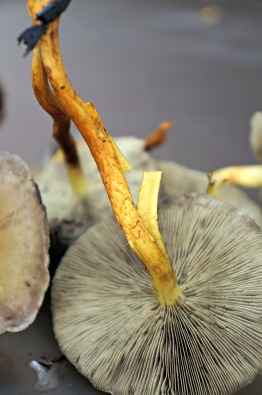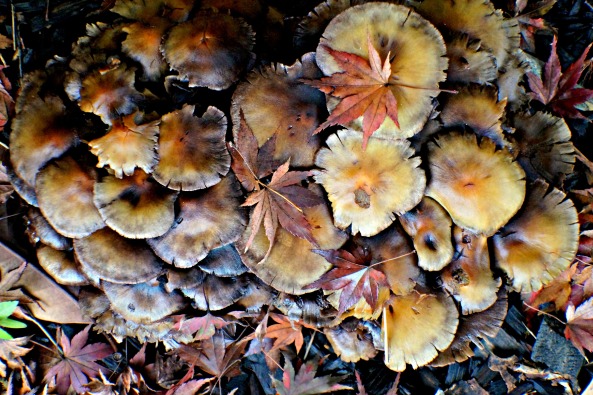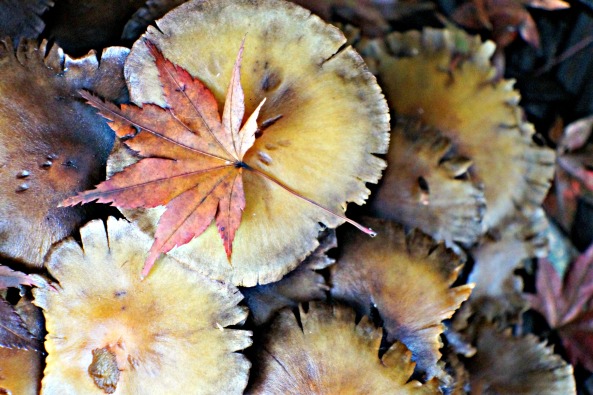Ringless Honey Mushrooms-Edible Wild Varieties or Poisonous? 
After doing extensive research to learn the correct species of this mushroom, I'm still not 100% sure that the fungi pictured here are in fact, Ringless Honey Mushroom aka (Armarilla tabescens). I would love to know, if for no other reason that I want to create delicious dishes with them. Things like mushroom omelettes and Southwestern Posole Stew with Jalapeño Cheddar Corn Sticks.
I spotted this cluster in my backyard growing out from a buried tree stump about two weeks ago. I'm 98.9% certain they are the same, but the fear of hallucinations and possible death has kept me from cooking up the batch.
Case and point: Grossly similar species include Pholiota spp. which also grow in cespitose clusters on wood and fruit in the fall. However Pholiota spp. have a yellowish to greenish yellow cast and a dark brown to grey-brown spore print. Mushroom hunters need to be especially wary of Galerina spp. which can grow side by side with Armillaria spp. also on wood. Galerina has a dark brown spore print and is deadly poisonous (alpha-amanitin) – see: mushroom poisoning. Source: wikipedia
Upon first inspection, the cluster had all the hallmarks of the honey mushroom, but after more inspection, and several days growth with drastic visible changes, it became more unclear.
I was unable to detect the fine hairs on the cap the first week of growth, so my first response was that they were poisonous mushrooms. To compact the issues of species detection, Northern California has been hit with a deluge of heavy rain rendering the more mature mushrooms, shiny and wet, making it difficult to get a good read on the species.
It's clear that I am not a Mushroom Expert (Mycologist) and without years of experience, I've erred on the side of caution and refrained from consuming these beautiful fungi however, they are the perfect specimen for photography.
Terms of Use: All content on this blog are the author’s personal views and opinions. The information provided is solely for entertainment and does not constitute any legal, medical, or other professional advice. It is not to be taken as fact nor absolute truth and it is not the author’s intention to do harm or to injure others. The author will not be held responsible for advice, tips, techniques, and recommendations used. Readers of this blog are to use it at their own free will and at their own risk.
Copyright: All text, images, and other content are the property of At Home with Rebecka unless otherwise noted, and may not be used for personal profit. You are welcomed to link to this blog, and to discuss its content in a respectful manner. Use of material from this blog according to fair dealing practices requires proper acknowledgment. When quoting or linking to this blog, please include At Home with Rebecka in the link and a permalink to that page.
Many mushrooms are poisonous some are deadly poisonous. We have made every effort to ensure accuracy on this website but, in the end, the responsibility for eating any mushroom or fungus must rest with the individual; for instance there are people who are allergic to all species of mushrooms. If you collect any mushrooms to eat make sure that your identification checks out in every detail. Never eat any wild mushroom until an expert mycologist has checked your identification. Even when you know a mushroom well weather conditions or animal damage can cause differences in appearance that could lead to misidentification.
If you are a Mushroom Expert (Mycologist) with knowledge of the species photographed here, please feel free to leave a comment and link to your website. I'm eager to learn more about my cluster of fungi and the possibility of cooking the next batch I find.
Are they or are they not Ringless Honey Mushrooms??
MORE HONEY MUSHROOM INFO:
Kuo, M. (2004, October). Armillaria mellea. Retrieved from the MushroomExpert.Com
Ecology: Pathogenic and parasitic on the wood of hardwoods (and occasionally on conifers); causing a white, pulpy rot in the wood; spreading through wood, and from tree to tree, by means of long black rhizomorphs; mushrooms typically appearing in large clusters on wood in the fall after rains, but found nearly year-round in warmer climates; eastern and southeastern North America.
Cap: 3-15 cm, convex to broadly convex or flat in age; the margin often arched in maturity; dry or tacky; color extremely variable, but typically honey yellow; smooth, or with a few tiny, dark scales concentrated near the center and vaguely radially arranged.
Gills: Attached or beginning to run down the stem; nearly distant; whitish, sometimes bruising or discoloring darker.
Stem: 5-20 cm long; .5-3.5 cm thick; tapering to base due to clustered growth pattern; tough and fibrous; smooth and pale near apex, darker and nearly hairy below; with a persistent ring at maturity and a white partial veil covering the gills when young.
Flesh: Whitish to watery tan.
Odor and Taste: Taste mild to bitter; odor sweet.
Spore Print: White.
Wikipedia: Honey fungus, or Armillaria or оpenky (Ukrainian: опеньки), is a genus of parasitic fungi that live on trees and woody shrubs. It includes about 10 species formerly lumped together as A. mellea.Armillarias are long lived and form some of the largest living organisms in the world. The largest single organism (of the species Armillaria solidipes) covers more than 3.4 square miles (8.8 km2) and is thousands of years old.[1] Some species of Armillaria are bioluminescent and may be responsible for the phenomena known as foxfire and perhaps will o' the wisp.
As a forest pathogen, Armillaria can be very destructive. It is responsible for the "white rot" root disease of forests and is distinguished from Tricholoma (mycorrhizal) by this parasitic nature. Its high destructiveness comes from the fact that, unlike most parasites, it doesn't need to moderate its growth in order to avoid killing its host, since it will continue to thrive on the dead material.
In the Canadian Prairies (particularly Manitoba), the term "honey fungus" is unknown to many; due to the large presence of Ukrainian Canadians in this area, the fungus is often referred to as pidpenky(Ukrainian: підпеньки), from the Ukrainian term, "beneath the stump".
The fruit bodies of the fungus are mushrooms that grow on wood, typically in small dense clumps or tufts. Their caps are typically yellow-brown, somewhat sticky to touch when moist, and, depending on age, may range in shape from conical to convex to depressed in the center. The stem may or may not have a ring. All Armillaria species have a white spore print and none have a volva (compare Amanita).[2]
Grossly similar species include Pholiota spp. which also grow in cespitose clusters on wood and fruit in the fall. However Pholiota spp. have a yellowish to greenish yellow cast and a dark brown to grey-brown spore print. Mushroom hunters need to be especially wary of Galerina spp. which can grow side by side with Armillaria spp. also on wood. Galerina has a dark brown spore print and is deadly poisonous (alpha-amanitin) – see: mushroom poisoning.
Edibility
Edible - Choice. Honey Fungus or pidpenky (Ukrainian: підпеньки) are considered in Ukraine, Russia, Poland, Germany and other European countries to be one of the best wild mushrooms and highly prized. They are commonly ranked above morels and chanterelles and only the cep / porcini is more highly prized. However pidpenky must be thoroughly cooked as they are mildly poisonous raw. Additionally one of the four UK species identified can lead to sickness when ingested with alcohol. Therefore for the non expert mycologist it is advisable not to drink alcohol for 12 hours before and 24 after eating this mushroom to avoid any possible nausea and vomiting. However, if these rules are followed this variety of mushroom is a delicacy with a strong distinctive mushroomy and nutty flavour. Recommended reference text for identification are Collins Complete British Mushrooms and Toadstools for the variety of field pictures in it and Roger Philips Mushrooms for the quality of his out of field pictures and descriptions.
Links
Kuo, M. (2004, October). Armillaria mellea. Retrieved from the MushroomExpert.Com
Photography by At Home with Rebecka








Roger
I've been picking and eating wild mushrooms for most of my life. Although similar, these mushrooms do not look like Ringless Honey Mushrooms to me. I suspect they are Hypholoma fasciculare due to the greenish gills, commonly known as the sulphur tuft which is bitter and poisonous; consuming it can cause vomiting, diarrhea and convulsions. You should check the spore color to clarify and learn to identify other distinguishing features. A If you are lucky, these could also be Hypholoma sublateritium, commonly known as the “Brick Cap” which is very good, but usually more reddish or brick colored.
athomewithrebecka
Hi Roger, Thank you so much for visiting At Home with Rebecka and leaving such a thoughtful and educated comment! How do I check spore color? I'm not sure these little beauties will return during the rainy season but want to check out the spores if they do. I probably won't ever get up enough nerve to eat them but learning more about the species would be a good thing! If you have a blog or web page with information pertaining to gathering and eating wild mushrooms, please share in the comments so I can take a peek!
Beverly
First: I am not an expert, only someone who has pursued wild edible mushrooms for some decades. Spore print is obtained by leaving the mushroom cap down on paper, preferably some of each white and black paper so you can see any color of spores on one or the other. I agree with Roger above that your closeup particularly looks much more like a poisonous sulphur tuft than a honey mushroom. I didn't see any of your photos that looked like honey mushrooms to me.
athomewithrebecka
Beverly, Thank you so much for sharing your wild mushroom expertise! I'm envious of the knowledge you have spent decades refining and hope to one day to grow in knowledge as you have. Mushrooms are mysterious and wonderful not only to eat, but to photograph. I really appreciate you taking the time to comment on my post!